“There is a horrible American vermouth — I shall not reveal its name.”
– Julia Child to Jacques Pepin
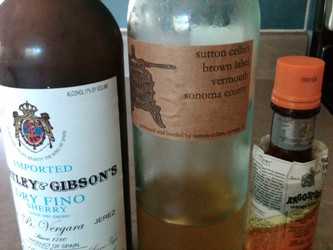 IT WAS A PLEASANT SURPRISE TO FIND OUT earlier this year from my friend Carl Sutton that his Sonoma County Brown Label vermouth, a labor of love if there ever was one, had been featured in the New York Times. I became a convert to this extraordinary aperitif wine last fall and subsequently plied friends and family with it between Thanksgiving and New Year’s Eve. At the end of January, I brought a bottle to a friend’s restaurant in Napa Valley to mix “Carlitos” (a Cava-sherry-vermouth cocktail; recipe noted below) for his manager and him. A couple of wine industry friends were in tow. It was roundly agreed that, on top of experiments with hand-made vermouth being a pleasant way to spend a Friday afternoon, this dry, rich, botanically expressive wine was good stuff. Then Jordan MacKay’s article appeared in the Times in early February. Echoing Julia Child, he observed that while the supermarket brand vermouths we Americans are used to drinking are almost unmentionable, the Brown Label is another beverage entirely. The publication of MacKay’s article was an event I figured would alter Carl’s world of artisan winemaking for good and perhaps, too, my chances of continuing to buy it at such a friendly price.
IT WAS A PLEASANT SURPRISE TO FIND OUT earlier this year from my friend Carl Sutton that his Sonoma County Brown Label vermouth, a labor of love if there ever was one, had been featured in the New York Times. I became a convert to this extraordinary aperitif wine last fall and subsequently plied friends and family with it between Thanksgiving and New Year’s Eve. At the end of January, I brought a bottle to a friend’s restaurant in Napa Valley to mix “Carlitos” (a Cava-sherry-vermouth cocktail; recipe noted below) for his manager and him. A couple of wine industry friends were in tow. It was roundly agreed that, on top of experiments with hand-made vermouth being a pleasant way to spend a Friday afternoon, this dry, rich, botanically expressive wine was good stuff. Then Jordan MacKay’s article appeared in the Times in early February. Echoing Julia Child, he observed that while the supermarket brand vermouths we Americans are used to drinking are almost unmentionable, the Brown Label is another beverage entirely. The publication of MacKay’s article was an event I figured would alter Carl’s world of artisan winemaking for good and perhaps, too, my chances of continuing to buy it at such a friendly price.
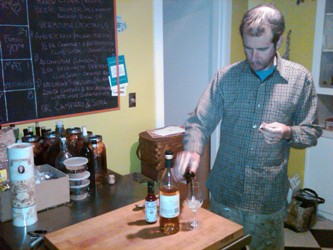 As both a friend and professional colleague, I’ve had a unique view into Carl’s winemaking world. Six years ago, I helped him sell his wines to a handful of restaurants and retailers in the Bay Area. Meeting at his and his wife’s San Francisco apartment to organize our sales plan, I took note of regular updates to the classroom-sized chalkboard on their kitchen wall. The board would tell intertwining tales. It served mainly as a calendar for a busy schedule of distributor visits across the country and event dates in and around the city. But also I recall notations of wine science data, interspersed with abacusian reminders (“$$owed from Ohio!”), domestic exhortations (“Buy coffee!!”), and a sidebar devoted to drink recipes and ideas, wacky and otherwise. The serious purpose of our work meetings notwithstanding, my powers of recall in the wake of visits to Carl’s flat have always been softened by his more formidable skills at hospitality. I have, in fact, come to believe that his favorite adjective to pair with the word “wine” is “fortified.” So The Chalkboard, like a kiss or a cigar, might just have been a chalkboard. What I know for sure is that Carl Sutton’s kitchen, like his mind, is an ideas factory for riffs on the theme of fermented grape juice.
As both a friend and professional colleague, I’ve had a unique view into Carl’s winemaking world. Six years ago, I helped him sell his wines to a handful of restaurants and retailers in the Bay Area. Meeting at his and his wife’s San Francisco apartment to organize our sales plan, I took note of regular updates to the classroom-sized chalkboard on their kitchen wall. The board would tell intertwining tales. It served mainly as a calendar for a busy schedule of distributor visits across the country and event dates in and around the city. But also I recall notations of wine science data, interspersed with abacusian reminders (“$$owed from Ohio!”), domestic exhortations (“Buy coffee!!”), and a sidebar devoted to drink recipes and ideas, wacky and otherwise. The serious purpose of our work meetings notwithstanding, my powers of recall in the wake of visits to Carl’s flat have always been softened by his more formidable skills at hospitality. I have, in fact, come to believe that his favorite adjective to pair with the word “wine” is “fortified.” So The Chalkboard, like a kiss or a cigar, might just have been a chalkboard. What I know for sure is that Carl Sutton’s kitchen, like his mind, is an ideas factory for riffs on the theme of fermented grape juice.
In the New York Times piece, Mackay touched on the one of those themes: a European tradition providing the creative spark for a California winemaking project. As he noted in his article, vermouth is a centuries-old beverage in Europe, and “Mr. Sutton…was inspired to infuse his wines after tasting vermouths from Italy.” Since founding the Sutton Cellars label in the mid-90s, Carl has been similarly inspired in the creation of other bottlings. His old-vines rendition of the red variety, carignane, is a wine he’s produced from a number of different California vineyards but which displays a decidedly rustic, Franco-Spanish profile. There’s also a fortified wine, “La Solera,” his unique take on barrel-aged, tawny Port which has fooled me more than once into thinking it came from Portugal. Since I’ve known him, Carl has regularly demonstrated what I consider other Iberian sensibilities: he likes to cook and eat tortillas (the Spanish kind, with eggs, onions, and potatoes); he’s not afraid to pull the cork on a 12 year-old rosado; and he enjoys dancing in bars, usually late at night.
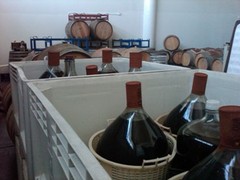 A few years ago, before the vermouth concept was a twinkle in his eye, Carl’s wife, Sharon, went on a work trip to Italy. As a professional restaurant designer who also happens to be married to a winemaker, she has an adventurous palate, and she returned with samples of liqueurs she’d been introduced to by colleagues in Milan. Carl was thus exposed to a variety of unique products, gathered more or less at the source, including limoncello, mandarin liqueur, and nocciola, made from hazelnuts. His creativity fueled by these liqueurs, he started experimenting with his own infusions. I was an early guinea pig: a bottle of harmless looking but really potent “pomelo-cello” made its way into our freezer two summers ago. My wife, Rachael, eyed it with what turned out to be prudent caution. Though it offered up a range of icy-citrusyflavors, sort of like a slushy spiked with sauvignon blanc, the net effect was a brain-freeze that thawed through a hangover.
A few years ago, before the vermouth concept was a twinkle in his eye, Carl’s wife, Sharon, went on a work trip to Italy. As a professional restaurant designer who also happens to be married to a winemaker, she has an adventurous palate, and she returned with samples of liqueurs she’d been introduced to by colleagues in Milan. Carl was thus exposed to a variety of unique products, gathered more or less at the source, including limoncello, mandarin liqueur, and nocciola, made from hazelnuts. His creativity fueled by these liqueurs, he started experimenting with his own infusions. I was an early guinea pig: a bottle of harmless looking but really potent “pomelo-cello” made its way into our freezer two summers ago. My wife, Rachael, eyed it with what turned out to be prudent caution. Though it offered up a range of icy-citrusyflavors, sort of like a slushy spiked with sauvignon blanc, the net effect was a brain-freeze that thawed through a hangover.
After a subsequent work trip to Milan, a bottle of Amaro Montenegro made it back to San Francisco in Sharon’s suitcase (amaro meaning “bitter” in Italian). This digestif was a game-changer for Carl. It drove home the idea that there exists a huge range of ingredients and flavors outside those of conventional winemaking, including the non-fruit and bitter realms of the flavor spectrum. The amaro model began to take firm hold of his imagination. “Limoncello and the idea of infusing things,” he told me recently, “got me thinking about infusing all manner of botanicals–herbs, roots, barks, seeds, flowers.” He summed it up: “You name it and I’ve probably thought about or tried infusing it.” Those who’ve read Patrick Süskind’s entertaining novel, Perfume, may be reminded here of the insane, serial-killing main character obsessed with extracting the aromatic essences of any and all substances he encounters. I think of Carl as a considerably more benign version of Grenouille, the evil parfumier, who, incidentally, is eaten by a crazed mob at the novel’s conclusion. I trust the story of Carl’s flavor obsessions will have a happier ending.
The staff and management at San Francisco’s popular Nopa Restaurant are no strangers to mobs. Thankfully, theirs go crazy for rotisserie chicken and little fried fish. Nor are they strangers to Carl–or vice versa. At least one of his late-night dancing performances occurred at this establishment. Despite (or, more likely, because of) such spirited antics, the Brown Label vermouth has inserted itself into the repertoire of the restaurant’s bartenders. Carl has a great supporter in Nopa’s bar manager, Neyah White, a talented mixologist whom he credits with planting the vermouth idea in his head a couple of years ago. At that time, in the midst of his kitchen experiments with infused liqueurs, Carl found he’d run into a dead end. “I didn’t have a distiller’s permit,” he confessed, “so it was really just experimenting with flavors for my own edification.” The vermouth project might never have been realized, but then something interesting happened. White tasted one of his fortified dessert wines at a party they were both attending and commented that he could imagine it as a substitute for sweet vermouth. I wasn’t surprised to hear this. On at least a couple occasions, I’ve tried delicious Port wine-based drinks from Nopa’s cocktail menu. “At that point,” Carl said, noting White’s observation at the party, “a little light bulb went on, and I started experimenting in earnest with the different botanicals. After about two years I came up with the prototype recipe.”
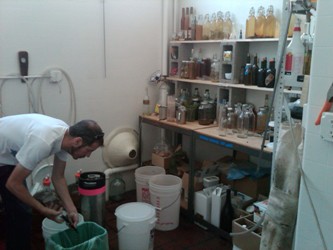 The initial recipe for dry, white vermouth was a stylistic decision Carl made largely because he had access to neutral-tasting Sonoma County white wine to use for the base wine. As a Sonoma-centric winemaker, he’d wanted to utilize the county’s appellation on the label, and the blank slate of a pleasant but otherwise uninteresting white wine provided a perfect vehicle for his blend of botanicals and fortifying grape brandy. The results were, and are, pretty stunning. Tasting the vermouth on its own and slightly chilled provokes some complex impressions on the palate. It could be the official libation of the Scarborough Fair: rosemary, sage, and cloves are among the descriptors I find useful; also mushrooms, beef broth, pepper, salt, lemons, oranges, dried flowers, and tea. The stuff is almost indescribably substantial, equal parts vegetable, mineral, and animal. It’s dry and elegant, in an herbal-citrusy-savory way, and at the same time rich and mouth-filling from the fortifying brandy. Gin may be its natural partner, but grape-based wines and spirits–brandy, sherry, and sparkling wine–also marry seamlessly to build elegant cocktails. Just ask Nopa’s White or the equally adventurous Daniel Hyatt at The Alembic in San Francisco, whose variation on the classic Bamboo Cocktail recipe is included below and whom Mackay gives credit in his Times article for the original idea to serve the vermouth on tap (“It pours really fresh when it’s glycol-chilled,” Hyatt told me on a recent visit, while making me the best martini I’d ever tasted. “There’s no dilution.”). For informed mixologists like White and Hyatt, the Brown Label vermouth is a key flavor component of any recipe in which it’s included. They enjoy having it close at hand. And like them, Carl comprehends how its flavors play with and against other wines and spirits.
The initial recipe for dry, white vermouth was a stylistic decision Carl made largely because he had access to neutral-tasting Sonoma County white wine to use for the base wine. As a Sonoma-centric winemaker, he’d wanted to utilize the county’s appellation on the label, and the blank slate of a pleasant but otherwise uninteresting white wine provided a perfect vehicle for his blend of botanicals and fortifying grape brandy. The results were, and are, pretty stunning. Tasting the vermouth on its own and slightly chilled provokes some complex impressions on the palate. It could be the official libation of the Scarborough Fair: rosemary, sage, and cloves are among the descriptors I find useful; also mushrooms, beef broth, pepper, salt, lemons, oranges, dried flowers, and tea. The stuff is almost indescribably substantial, equal parts vegetable, mineral, and animal. It’s dry and elegant, in an herbal-citrusy-savory way, and at the same time rich and mouth-filling from the fortifying brandy. Gin may be its natural partner, but grape-based wines and spirits–brandy, sherry, and sparkling wine–also marry seamlessly to build elegant cocktails. Just ask Nopa’s White or the equally adventurous Daniel Hyatt at The Alembic in San Francisco, whose variation on the classic Bamboo Cocktail recipe is included below and whom Mackay gives credit in his Times article for the original idea to serve the vermouth on tap (“It pours really fresh when it’s glycol-chilled,” Hyatt told me on a recent visit, while making me the best martini I’d ever tasted. “There’s no dilution.”). For informed mixologists like White and Hyatt, the Brown Label vermouth is a key flavor component of any recipe in which it’s included. They enjoy having it close at hand. And like them, Carl comprehends how its flavors play with and against other wines and spirits.
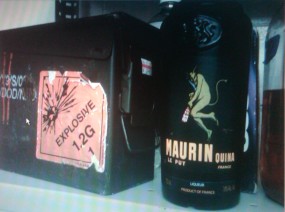 In creating the vermouth, Carl has honored, in his own words, “the tradition of using plants infused in alcohol…to make the aperitifs, digestifs, and liqueurs that have existed for centuries in Europe.” As they do for many California winemakers and distillers (and craft brewers, for that matter), European traditions form a big wedge in the sphere of influence on the Sutton Cellars wines. France, Spain, and Portugal have hovered, muse-like, in the corners of his active imagination for years. The Brown Label vermouth and its attendant nod to Italy represent another step towards what I’d describe as a “Mediterranean Rim” business model. Happily, this model is far from complete. Carl recently moved his winemaking operation from Sonoma to a warehouse space in San Francisco. A sweet vermouth bottling and a proper digestif are scheduled for release from the new facility later this year. In the meantime, The Chalkboard remains at home in his and Sharon’s apartment, its calendar as full as ever. Carl’s kitchen experiments are set to continue along the trial-and-error lines that brought about the vermouth. Who knows what will follow? Help us all if homemade Absinthe is one of the cards he’s keeping close to his chest, though I can’t say for sure that the notorious wormwood isn’t already part of his vermouth recipe. It wouldn’t surprise me. If I find myself dancing late at night at Nopa or The Alembic–and not remembering certain events the next morning–I may have confirmed my own suspicions.
In creating the vermouth, Carl has honored, in his own words, “the tradition of using plants infused in alcohol…to make the aperitifs, digestifs, and liqueurs that have existed for centuries in Europe.” As they do for many California winemakers and distillers (and craft brewers, for that matter), European traditions form a big wedge in the sphere of influence on the Sutton Cellars wines. France, Spain, and Portugal have hovered, muse-like, in the corners of his active imagination for years. The Brown Label vermouth and its attendant nod to Italy represent another step towards what I’d describe as a “Mediterranean Rim” business model. Happily, this model is far from complete. Carl recently moved his winemaking operation from Sonoma to a warehouse space in San Francisco. A sweet vermouth bottling and a proper digestif are scheduled for release from the new facility later this year. In the meantime, The Chalkboard remains at home in his and Sharon’s apartment, its calendar as full as ever. Carl’s kitchen experiments are set to continue along the trial-and-error lines that brought about the vermouth. Who knows what will follow? Help us all if homemade Absinthe is one of the cards he’s keeping close to his chest, though I can’t say for sure that the notorious wormwood isn’t already part of his vermouth recipe. It wouldn’t surprise me. If I find myself dancing late at night at Nopa or The Alembic–and not remembering certain events the next morning–I may have confirmed my own suspicions.
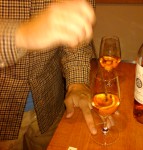 Recipes
Recipes
As I’ve mentioned, Sutton Cellars vermouth is wonder juice for mixologists. Neyah White and his enthusiastic bartenders at Nopa Restaurant use it as the base for a little miracle of a cocktail called the Brown Label Shrub. They mix it with a proprietary huckleberry infusion, stir it with ice, then strain and garnish it with a twist of lemon peel. It’s served in a sherry copita. Brilliant.
(Incidentally, the process by which a huckleberry infusion is made reminds me of high school chemistry: profoundly confusing. I plan to exorcise this latent educational demon in a subsequent article and interview with Neyah, who is a font of information on the subject of booze. Anyone who has read this far and wants to know more right away about huckleberry or other fruit infusions should email me to be put in touch with him.)
To complement my short tribute to the shrub, here are a few other vermouth drink recipes that, for the entertainment of friends, spouses, and significant others, are easier to reproduce at home:
The Bamboo Cocktail (aka The Punji Stick)
Carl introduced me to the classic Bamboo earlier this year. The straightforward version calls for an ounce or so each of fino (dry) sherry and vermouth with a dash of orange bitters. I’ve made it with amontillado sherry, which is off-dry and rich. It changes the profile of the drink (and the name, too, I suppose): it’s less delicate. This isn’t necessarily a bad thing–just different. When I tried the amontillado version on Rachael, she said it tasted like “bitter caramel with a citrus twist.”
 On a visit to The Alembic in San Francisco, Daniel Hyatt told me, “What I like about mixing fino sherry with vermouth is it emphasizes the minerality and ‘citrusy-ness.’ I lean towards drier cocktails, anyway.” To illustrate his point, he made me a variation on the Bamboo, in which he substituted Curaçao liqueur for the orange bitters. He dubbed it “The Punji Stick.” The cocktail is dry and subtle, and it highlights the interplay between vermouth’s herbal flavors and the nutty-oxidative qualities of fino sherry. Curaçao accentuates the citrus character of the vermouth.
On a visit to The Alembic in San Francisco, Daniel Hyatt told me, “What I like about mixing fino sherry with vermouth is it emphasizes the minerality and ‘citrusy-ness.’ I lean towards drier cocktails, anyway.” To illustrate his point, he made me a variation on the Bamboo, in which he substituted Curaçao liqueur for the orange bitters. He dubbed it “The Punji Stick.” The cocktail is dry and subtle, and it highlights the interplay between vermouth’s herbal flavors and the nutty-oxidative qualities of fino sherry. Curaçao accentuates the citrus character of the vermouth.
Equal parts (1 to 1½ oz. each) fino sherry and vermouth
Dash of Curaçao liqueur
Stir with ice and strain into a small wine glass, garnish with a twist of lemon peel.
The Carlito
This drink is probably in a recipe book or bartenders’ manual somewhere. The version below was named by me for, as you might guess, our vermouth maker. I first heard his name mentioned in the Spanish diminutive a few years ago. A mutual friend called me from Carl’s apartment at 2:00 in the morning, midway through a late-night session of Sazeracs. During the call, a giant noise exploded through the phone into my ear. An ungodly heavy piece of iron furniture had gone crashing to the kitchen floor. “Carlito,” as our friend had called him then, was to blame. The name stuck and has awaited its own cocktail.
3½oz. Cava
1 oz. vermouth
1 oz. amontillado sherry
Pour all into a Champagne flute and stir.
The Sutton Sour
Heather Davis, who is one of the bartenders at Annabelle’s Bistro in downtown San Francisco, created a rye whiskey entry for “Science of Cocktails,” a mixology competition and fundraiser at The Exploratorium museum earlier this year. It struck me as funny, in an alarming sort of way, that the drink’s public debut was at a children’s museum. She based the recipe on The Sutton Sour, a popular cocktail at Annabelle’s that Heather and her colleagues make with bourbon.
1½ oz bourbon
1 oz vermouth
½ oz lemon juice
½ oz simple syrup
Dash of orange bitters
Stir with ice, strain into a martini glass.
The Daniel Hyatt Martini
 No one in my experience does a better job than Dan Hyatt handling the two classic, infused beverages, vermouth and gin. He’s like a chef or winemaker who lets the ingredients or the grapes speak for themselves in the finished product.
No one in my experience does a better job than Dan Hyatt handling the two classic, infused beverages, vermouth and gin. He’s like a chef or winemaker who lets the ingredients or the grapes speak for themselves in the finished product.
2 oz. Beefeater gin
½ oz. vermouth
Dash of orange bitters
Stir with ice, strain into glass of preference.